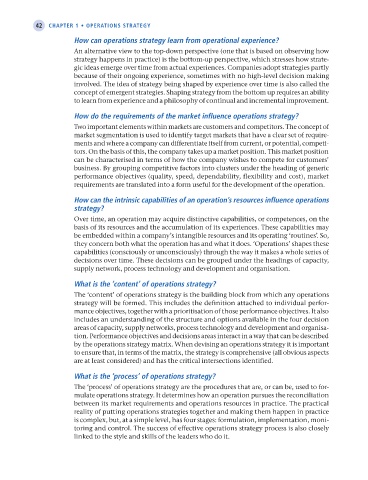Page 67 - Operations Strategy
P. 67
42 CHAPTER 1 • OPERATiOns sTRATEgy
how can operations strategy learn from operational experience?
An alternative view to the top-down perspective (one that is based on observing how
strategy happens in practice) is the bottom-up perspective, which stresses how strate-
gic ideas emerge over time from actual experiences. Companies adopt strategies partly
because of their ongoing experience, sometimes with no high-level decision making
involved. The idea of strategy being shaped by experience over time is also called the
concept of emergent strategies. Shaping strategy from the bottom up requires an ability
to learn from experience and a philosophy of continual and incremental improvement.
how do the requirements of the market influence operations strategy?
Two important elements within markets are customers and competitors. The concept of
market segmentation is used to identify target markets that have a clear set of require-
ments and where a company can differentiate itself from current, or potential, competi-
tors. On the basis of this, the company takes up a market position. This market position
can be characterised in terms of how the company wishes to compete for customers’
business. By grouping competitive factors into clusters under the heading of generic
performance objectives (quality, speed, dependability, flexibility and cost), market
requirements are translated into a form useful for the development of the operation.
how can the intrinsic capabilities of an operation’s resources influence operations
strategy?
Over time, an operation may acquire distinctive capabilities, or competences, on the
basis of its resources and the accumulation of its experiences. These capabilities may
be embedded within a company’s intangible resources and its operating ‘routines’. So,
they concern both what the operation has and what it does. ‘Operations’ shapes these
capabilities (consciously or unconsciously) through the way it makes a whole series of
decisions over time. These decisions can be grouped under the headings of capacity,
supply network, process technology and development and organisation.
What is the ‘content’ of operations strategy?
The ‘content’ of operations strategy is the building block from which any operations
strategy will be formed. This includes the definition attached to individual perfor-
mance objectives, together with a prioritisation of those performance objectives. It also
includes an understanding of the structure and options available in the four decision
areas of capacity, supply networks, process technology and development and organisa-
tion. Performance objectives and decisions areas interact in a way that can be described
by the operations strategy matrix. When devising an operations strategy it is important
to ensure that, in terms of the matrix, the strategy is comprehensive (all obvious aspects
are at least considered) and has the critical intersections identified.
What is the ‘process’ of operations strategy?
The ‘process’ of operations strategy are the procedures that are, or can be, used to for-
mulate operations strategy. It determines how an operation pursues the reconciliation
between its market requirements and operations resources in practice. The practical
reality of putting operations strategies together and making them happen in practice
is complex, but, at a simple level, has four stages: formulation, implementation, moni-
toring and control. The success of effective operations strategy process is also closely
linked to the style and skills of the leaders who do it.
M01 Operations Strategy 62492.indd 42 02/03/2017 13:00

